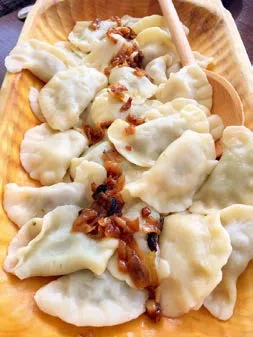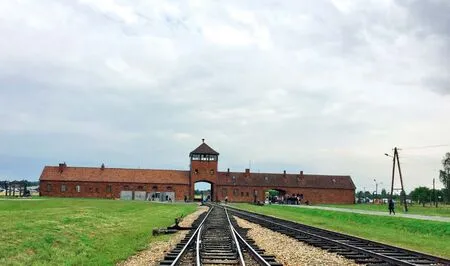克拉科夫:当海洋遇见草原
2019-04-22◇文
◇ 文
上帝似乎格外钟爱克拉科夫,二战期间,这座中世纪古都在波兰灭国时竟奇迹般地躲过了战火和炮弹。

一段源远流长的波兰首府史与数次主权易手他国的沦陷史在这里交织,让克拉科夫成为中欧最迷人的旅游目的地之一,在现代与历史、抗争与屈服、民主与暴力的天秤上不断平衡,在正反左右之间徘徊选择。
It seems that Kraków is especially favored by God.During the World War II, this ancient capital in the Middle Ages miraculously escaped the warfare and cannonball.
With the long history of being the capital of Poland and being occupied by the enemies with sovereignty falling into other countries’ hands for several times,Kraków has been one of the most fascinating tourist destinations in the central Europe. Where, the modernity and history, resistance and surrender, democracy and violence keep balance and left and right wander.
历史镌刻着鎏金岁月
Gold Years Engraved By the History
1038年到17世纪前,克拉科夫一直是波兰的首都,直到波兰王国及立陶宛大公国联邦成立四十年迁都华沙后,才失去了政治中心的地位。
但在波兰的黄金历史上,位于西欧海洋文明与远东草原文明碰撞交界点的克拉科夫,创造和保留着灿烂辉煌的中世纪和文艺复兴时期文化,诸如发表“日心说”的天文家哥白尼曾在此就读大学,博物馆珍藏着肖邦最后的钢琴,当地机场以大教宗约翰·保罗二世命名……
尽管克拉科夫也跟命运多舛的波兰一样遭遇了惨痛的摧残和浮沉,所幸的是古城依然保留着中世纪的基本样貌,1978年被列入世界文化遗产名录,供世人跨越时空共享那段烟波浩渺的鎏金岁月。
了解这座城市的首都史,不妨从金碧辉煌的瓦维尔山开始。
坐落在古城之南的石灰岩山丘瓦之巅是历代波兰王室和主教活跃的主舞台。哥特式建筑风格的瓦维尔城堡是波兰旧都的权力象征、中世纪克拉科夫的形象代言,曾经抵挡过“上帝之鞭”蒙古铁骑的进攻,这绝对是欧洲城堡史上浓墨重彩的一笔。如今依然富丽堂皇的国事厅是最华丽的建筑主体之一,皇家私人寓所同样美轮美奂,皇家财宝库与军械部则炫耀着辉煌时代权力的游戏,东方艺术博物馆展出了欧洲皇室对近东、中东和远东艺术的异域风情收藏癖是如何实现的,“失落的瓦维尔”则是一座考古史博物馆。

瓦维尔皇家花园与城堡


波兰饺子与烤肉组合
城堡建筑之间,耸立着瓦维尔主教座堂,波兰王室在此加冕成就人生巅峰,最终尘归尘土归土,死后又多安葬于此。此外,也有很多波兰名人长眠于斯,这里是波兰名副其实的国家圣殿。教堂南端的西吉斯蒙德小教堂建成于1539年,据说圆顶是黄金打造的,安葬着同名国王一世和二世,是极纯净的文艺复兴建筑。
Kraków had been the capital of Poland from 1038 till the 17th century. It hadn’t lost its status as political center until the Kingdom of Poland and Commonwealth of Grand Duchy of Lithuania moved the capital to Warsaw when it was founded for 40 years.
However, in Poland’s golden history, Kraków,located at the junction point where western European maritime civilization and far east prairie civilization collided, had created and maintained the glorious and resplendent culture in the Middle Ages as well as the renaissance culture, such as the university where Copernicus the astronomer, who published “heliocentric theory”once studied here, the museum where the last piano played by Chopin and the local airport which was named with the Pope John Paul II...
Though Kraków had suffered painful destroy, sink and emerge, just like its country Poland, which suffered many mishaps, it is fortunate that the ancient city still has kept the basic looks of that in the Middle Ages. In 1978, it was listed in the World Heritage List for people of the world to span time and space to share the remote and unforgettable golden years.
To have a knowledge of the capital history of the city, we might start from the magnificent Wawel.
Situated in the limestone massif in the south of the ancient city is the main stage for the Poland royal families and bishop to live for the past dynasties. Wawel Castle in Gothic style is the symbol of power of Poland’s former capital and representative of image of Kraków in the Middle Ages. It once resisted the attack of Mongolia cavalry, renowned as “Scourge of God”,and this is absolutely the most splendid chapter of the masterpiece of European Castle History. Nowadays, the grand State Room is still one of the most magnificent building structures; the private home for royal families is incredibly beautiful and the royal treasury and ordnance department exhibit the game of thrones in the glory ages; the Oriental Art Museum displays the artistic works from Near East, Middle East and Far East collected by European royal household and shows how its collectomania is realized; “The Lost Wawel” is a museum of archaeology.
Wawel Cathedral stands on the castle buildings and it is the place where Poland royal house coronated and reached their pinnacle of life and at last were buried here after they died. In addition, many celebrities in Poland also lied and rested here and this is the genuine national temple in Poland. The Sigismund’s Chapel at the south end of the Cathedral was built in 1539. It is said that the dome was built by god and Sigismund King I and II were buried here, which is a pure renaissance architecture.
探访老城的中世纪魅力
Pay A Visit to the Old Town to Enjoy the Charm of Middle Ages
若不想体验沉重的历史,在皇家花园散步或者坐在城堡上眺望维斯瓦河,或者在河对岸搭乘热气球鸟瞰全景,都是绝妙的消遣。
当然,皇室和宗教都未必太有距离感,穿行在老城中探访中世纪的魅力才是正经事呢!
中央集市广场是古城的心脏,是这座城市永葆活力的秘密之源。中央集市广场始建于1257年,是欧洲最大的中世纪广场,长宽各约200米。同样是中世纪市政广场,比佛罗伦萨领主广场开阔、比锡耶纳田野广场方正、比塔林市政广场大气、比布鲁塞尔大广场精致。
高约70米的市政厅钟楼是古城的天际线,看起来像镇妖利剑,誓要斩尽一切魑魅魍魉。事实上,钟楼地下层是一座阴森恐怖的监狱。与钟楼浑然一体的,则是广场中心的纺织会馆,这座文艺复兴建筑见证了克拉科夫的兴衰沉浮,这里既接纳来自东方的香料丝绸,也出口维利奇卡盐矿出产的盐,国际贸易一度兴旺繁荣。
最诡谲的是,这座建筑至今在审美与世俗之间寻求折衷,楼上是国家美术馆,展出19世纪的波兰绘画与雕塑;楼下是“市列珠玑、户盈罗绮”的工艺品市场,人头攒动、熙熙攘攘,充满着烟火市井的气息,让人感动。
广场东北是比钟楼更高的、更有仪式感的圣母圣殿(圣玛丽教堂),这座被称为“波兰主教座堂风格”的圣殿,是海外波兰人建设当地社区宗教场所的范本。哥特式建筑主题和木制祭坛是看点,但最令人关注的还是每小时都会从顶端响起的号角声,据称是纪念抗击蒙古军队攻城时,报警遇害的小号角手。
走出这个中心区域,在古城中随意游走同样充满惊喜。热情友善的克拉科夫居民的各色商店、餐馆、旅社、酒吧,以最具当地特色的卖点延请客人,用小波兰的方式铭刻克拉科夫的城市记忆。
以美食为例,并不需要刻意去点评榜上的名店,很多餐厅名不见经传,但有种浓郁的艺术装修风格和一流的大厨水准,尝一下波兰饺子、波兰香肠、波兰血肠、红菜头汤、灌汤面包、猪肉苹果泥……听来是不是让人口舌生津?
其实,这里的美食比较接近东欧风味,味道也很可口。最重要的是,价格真的很“亲民”,相比西欧价格要便宜三分之一左右,更别提北欧。
或者要一杯饮品,咖啡或啤酒,坐在广场旁的小店,喂喂鸽子、晒晒太阳,偷得浮生半日闲,体会古城人民是如何在历史与现代之间寻求内心的平衡,如此接地气地生活在这样的钟灵毓秀之地。如果还不累,或可以沿着古城的八个老城门走一圈,或是去东南边的卡齐米区犹太人区转转,都是体验克拉科夫最亲近的方式。
If you don’t feel like experiencing the heavy history and want to take a walk in the Royal Garden or just sit on the castle to overlook the Vistula, or ride the hot air balloon at the opposite bank to get a bird’s-eye view, all will be excellent pastime.
Certainly, the royal and religion don’t always give us a sense of distance and it is a marvelous experience to pass through the old town to visit the charm of Middle Ages!

Rynek Główny is the heart of the old town, which is also the source of secret that the city always keeps the vitality. Built in 1257, Rynek Główny is the largest square in the Middle Ages in Europe with about 200m in the length and width. It is also the municipal square in the Middle Ages, which is more open than Piazza della Signoria in Florence, more square than Piazza del Campo in Siena, more grand than Tallinn Municipal Square and more exquisite than Grand Place in Brussels.
The municipal hall bell tower is the skyline of the ancient city, which looks like a sharp sword that can kill all sorts of evil spirits. In fact, the basement of bell tower is a spooky and horrible prison. A unified entity of bell tower is the Sukiennice, Cloth Hall at the center of the square. This renaissance architecture has witnessed the rise and fall of Kraków, where the spice and silk from the oriental were imported and the salt produced by Wieliczka Salt Mine was exported. The international trade once was very thriving and prosperous here.
What is ingenious is that this building is still seeking for compromise between the aesthetic and wordly.The upper storey is the National Art Gallery exhibiting the Poland paintings and sculpture in the 19th century.While the lower storey is the craft market with a wide variety of commodities, where it is bustling and crowded full of vitality.
Situated at the northeast of the square, taller and more ritual than bell tower is the Basilica of Our Lady (St Mary’s Basilica). As a holy basilica reputed as “Poland cathedral style”, it is the model for oversea Polish to build local community and religious places. The Gothic architecture theme and wooden altar are the features,but what is more attractive is the clarino ringing out from the top every hour. It is said that this is to commemorate the bugle boy who was killed by his giving an alarm when the Mongolian army attacked the city.
If you walk out of the central zone, you will also be pleasantly surprised by wandering at will in the ancient city. The hospital and friendly citizens, all kinds of stores, restaurants, hotels and bars will all impress you.They entertain the guests with the most fascinating local style to engrave the city memory of Kraków with their own local way.
Let’s take the food for example. We don’t need to surf the internet to search which restaurants are good,because we will find many little known restaurants are very impressive with their strong artistic decoration style and first-class cooking. Just take a taste of Pierogi,Polish Sausage, blood sausage, beetroot soup, bread in soup and pork apple mud, it will will attract your taste bud and stimulate your appetite.
The food here is close to Eastern Europe flavor and it is very delicious. What’s more, the price is very cheap, about 1/3 cheaper than that in Western Europe,let alone Northern Europe.
You may order a cup of drink, coffee or beer, sit in a small store of the square, feed the pigeons or bask in the sun to find a moment of leisure and experience how the ancient city people seek for a balanced state of mind between the history and modern times. If you are still not tired, you can walk around the eight old gates or stroll in the Kazimierz District or ghetto at the southeast of the ancient city, which are all the excellent ways to experience the Kraków to the most.
那一抹无法磨灭的记忆
Formidable Wind and Snow:Minimum Respect for Winter
克拉科夫不可不提的沦陷史上最黑暗时期的见证,莫过于奥斯威辛-比克瑙集中营。但凡有点二战记忆的,都不可能忘却纳粹德国对犹太人种族灭绝式的屠杀,在电影如《辛德勒的名单》《美丽人生》《穿条纹睡衣的男孩》等佳作里,都有很好的描绘与叙述,但真真切切置身于集中营中时,那种绝望和恐惧是摧毁式的直击人心。
从克拉科夫乘坐便捷的旅游巴士直达奥斯维辛,正好下着暴雨,原本温暖的天气一下子变得“天阴雨湿声啾啾”。这座废弃军营从1940年起变成人间炼狱,能够从事劳动的知识分子、战俘、罪犯、同性恋者被关押于此,为战争机器运作而转动,而更多的犹太人、妇女、儿童、老人、伤残者就直接处决。
奥斯维辛集中营博物馆展出了二战期间被戕害的100万以上受害者的生存状态与当时的国际关系,最令人毛骨悚然的是,除了随身财物被剥夺之外,连死者的金牙、头发、皮肤、脂肪都被完全利用,用来编织毛毯、制造肥皂或熔铸金币。二号比克瑙集中营则更丧心病狂,一段铁路把囚犯拉进集中营筛选,几百座木排房条件比奥斯维辛更恶劣,因为这里被定性为“灭绝营”,最恐怖的是行刑场和毒气室,说是给囚犯“洗澡”,脱光之后就直接用氯化氢大规模毒杀,再送进焚尸炉。这些从电影中看过的场景如此活生生出现在眼前,带给心灵的冲击和震撼是窒息式的压抑,试想在这样的地狱中,谁能逃此一劫?众生平等,但愿反人类的悲剧不再重演。
承载过辉煌与耻辱的克拉科夫,在新时代还焕发着盎然的生机。爱好和平、力求和谐,是克拉科夫的城市品格,维系着历史赋予它的温文儒雅和亲和包容的特质,续写着波兰历史不平凡的新一页。
We couldn’t help but mention the darkest period of the history of Kraków-Auschwitz-Birkenau. Anyone who knows something of WWII would never forget the genocide massacre that Nazi Germany did to the Jews.The films such as Schindler’s List, Life Is Beautiful,The Boy In The Striped Pyjamas have well described and portrayed the cruel scenes. But if you truly put yourself in it, you will feel the direct stroke of despair and fear and that is destructive.

比克瑙的地狱之门
When we took a tourist bus from Kraków to Auschwitz, it was raining cats and dogs and the warm weather suddenly became overcast and wet. This discarded military camp had been the living hell since 1940, where all kinds of intellectuals, prisoners of war,criminals and gays who could still work were locked up here to work for the war machine operation. While more Jews, women, children, elders and disabled were put to death directly here.
Auschwitz Concentration Camp Museum has displayed the survival conditions of more than 1 million victims killed during WWII and the then international relationship. What is creepy is except that the deceased’s belongings was robbed, their gold teeth,hair, skin and fat were made full use to weave blanket,make soap or cast gold coin. The Birkenau Concentration Camp was more frenzied because it was called “extermination camp”. And the most terrifying things were execution field and gas chamber. They called it “wash”for the prisoners and then killed them with poisonous hydrogen chloride after they took off the clothes and then sent them to the cinerator. When the scenes which used to appear in the films appeared in front of your eyes,you will feel the heart shock and suffocated suppression.Who could escape from the disaster in such a hell? Everyone is equal! We sincerely hope that the antihuman tragedy won’t repeat.
Kraków, a city bearing the glory and hulimiation, is still vibrant with life in the new age. Loving peace and striving for harmony is the city character of Kraków,which is maintaining the culture granted by the history and writing the new page of extraordinary history of Poland.
